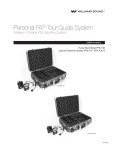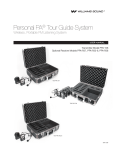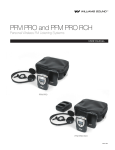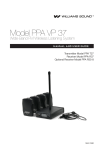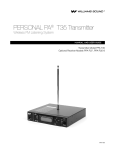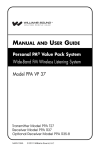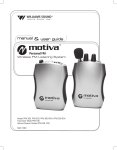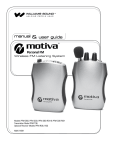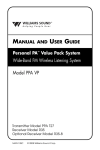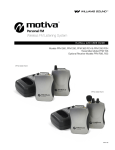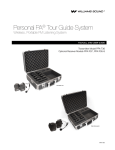Download Williams Sound PPA T36 User guide
Transcript
Manual and User Guide Personal PA® Tour Guide System Wireless, Portable FM Listening System Transmitter Model PPA T36 Optional Receiver Models PPA R37, PPA R35-8 MAN 158A PERSONAL PA® FM Tour Guide System, Models TGS PRO 720, TGS PRO MULTI Manual & User Guide Contents Page System Components 3 System Overview 3 Safety Information 4 Recycling Instructions 4 Operating Instructions PPA T36 Transmitter PPA R37 Receiver 7 PPA R35-8 Receiver 8 Belt Clip Removal/Installation 9 Battery Information 10 Optional Battery Chargers 11 Hints for Using the System 12 In Case Of Difficulty 13 Warranty 14 System Specifications 2 5-6 15-16 System Components Body Pack Transmitter (PPA T36) with (2) AA batteries (BAT 001) Noise-cancelling headband microphone (MIC 100) (10) Receivers (PPA R37 or R35-8) w/batteries (BAT 001) Instruction manual (MAN 145) System carry case (CCS 030 S) System Overview The Personal PA® Tour Guide System is a portable, high-performance, wireless listening system. It is composed of a PPA T36 Transmitter, microphone, and optional PPA R37 or R35-8 receivers equipped with headphones or earphones. The system allows one-way transmission of a tour guide’s voice to group members using an FM radio signal. Using the system helps group members overcome background noise and distance from the person speaking. The Personal PA® Tour Guide System can be used for large or small tour groups, and in noisy or quiet environments. Your Personal PA® Tour Guide System has two principal parts: the transmitter and the receiver. Much like a miniature radio station, the transmitter and microphone pick up the sounds you want to hear and broadcast them over an FM radio signal. The receivers and headphones are used to pick up the broadcast up to 100 meters away. To avoid difficulties, please read through these instructions as you begin to use the system. Then save them for questions that arise as you continue to use your system. If you have problems with the Personal PA® Tour Guide System, don’t hesitate to call Williams Sound at 1-800-843-3544 or +1 952 943 2252. FIG 1: How the Tour Guide System Works FM Radio Signal Tour Guide Uses the Body Pack Transmitter With Microphone Listeners use Personal Receivers with Headphones, Earphones, Or Neckloop 3 Safety Information Hearing Safety: CAUTION! The tour guide system is designed to amplify sounds to a high volume level which could potentially cause hearing damage if used improperly. To protect your hearing and the hearing of others: 1. Make sure the volume on the receiver is turned down before putting on the earphone or headphone. Then adjust the volume to a comfortable level. 2. Set the volume level on the receiver at the minimum setting that you need to hear. 3. If you experience feedback with the receiver (a squealing or howling sound), reduce the volume setting and move away from the T36 transmitter’s microphone. 4. Do not allow children or other unauthorized persons access to the receiver. Battery Safety and Disposal: CAUTION! The transmitter and receiver may be supplied with alkaline batteries. Do not attempt to recharge alkaline batteries, which may explode, release dangerous chemicals, cause burns, or other serious harm to the user or product. Pacemaker Safety: CAUTION! 1. Before using this system with a pacemaker or other medical device, consult your physician or the manufacturer of your pacemaker or other medical device. 2. If you have a pacemaker or other medical device, make sure that you are using this product in accordance with safety guidelines established by your physician or the pacemaker manufacturer. Recycling Instructions Help Williams Sound protect the environment! Please take the time to dispose of your equipment properly. Product Recycling Instructions: Please do NOT dispose of your Williams Sound equipment in the household trash. Please take the equipment to an electronics recycling center; OR, return the product to the factory for proper disposal. Battery Recycling Instructions: Please do NOT dispose of used batteries in the household trash. Please take the batteries to a retail or community collection point for recycling. 4 Using the T36 Transmitter 1. Make sure there are two alkaline or rechargeable AA batteries in the transmitter. If batteries are not installed, see Battery Information on page 11. 2. Plug the microphone cord into the “Mic Jack” on top of the transmitter (FIG. 2). FIG 2: T36 Top View Auxiliary Input Power On/Off/Mute Mic Jack Channel Selector Power On Indicator 3. Optionally, plug in a desired audio source such as a CD or MP3 player using the “Auxiliary Input” jack (WCA 087 stereo auxiliary input cable included). If mic and auxiliary sources are used together, the audio will be mixed. If only auxiliary source is desired, the mic can be muted. Do not remove the mic from the “Mic Jack” as the cable is also the transmitting antenna! 4. Turn the unit on: press and hold the “ON/OFF/MUTE” FIG 3: Channelization Chart button for three seconds. The “Power On” indicator should illuminate green. T36 Freq. R35-8 CH Letter (MHz) CH 5. Select the desired operating frequency. Use the “Channel Selector” knob to select any of the 16 A 72.1 1 1 B 72.3 2 2 available channels on 72-76 MHz. Refer to the O 72.6 3 3 channel selection chart, FIG 3. Make sure the receiver being used is operating on the same frequency as the T36 transmitter! NOTE: Up to eight T36’s can operate simultaneously on channels 1-8 (FIG. 3) when used with an R35-8 receiver. 6. Position the headset microphone boom as close to the speaker’s mouth as possible without actually touching. Lapel clip microphones should be attached to a collar or lapel, as close to the speaker’s mouth as possible. The transmitter can be placed in a pocket, or clipped onto a belt or waistband. 4 5 6 7 8 9 10 11 12 13 14 15 16 P I R G H C K N D E J S T 72.8 74.7 75.4 75.7 75.9 72.5 72.2 72.4 72.7 72.9 75.3 75.6 75.8 4 5 6 7 8 - 7. When you pause from speaking, you may mute the microphone by pressing the “ON/OFF/MUTE” button once momentarily. The “ON/OFF/MUTE” button will flash red. To unmute the mic, press the “ON/OFF/MUTE” button once momentarily again. IMPORTANT: When the T36 transmitter is not being used, remember to turn the unit OFF by pressing and holding the “ON/OFF/MUTE” button for three seconds. The “Power On” indicator should not be lit. 5 Using the T36 Transmitter, cont. Gain Control The gain control can be used to adjust the volume level on both the microphone and auxiliary input. To adjust the volume level, open the battery door and locate the Gain Control (FIG. 4). Use the supplied plastic screwdriver and rotate to increase “+” or decrease “-” the gain. FIG 4: T36 Controls 2:1 1:1 - Gain + - AUX + Comp CH Lock – AA + + AA – j k l m 1. Gain Control 2. Auxiliary Input Level 3. Compression Selector 4. Channel Lock Auxiliary Input Level The auxiliary input level can be used to adjust the auxiliary input level only. To adjust, open the battery door and locate the Auxiliary Input Level (FIG. 4). Use the plastic screwdriver and rotate to increase “+” or decrease “-” the input level. Note: When using an auxiliary audio source, if the “Aux Input Level” is set too high, there can be increased audio distortion and decreased battery life. Note: When using an auxiliary input source, the mic must be plugged in to the “Mic Jack” in order to transmit audio! Compression Selector By default, the T36 compression is set to “Off” for normal operation, or “1:1” compression. For hearing assistance applications, the compression selector can be set to “On” for “2:1” compression. To change this setting, open the battery door and locate the Compression Selector (FIG. 4). To turn on compression (2:1), slide the “Comp” switch to the position marked “2:1.” To turn off, slide the “Comp” switch to the position marked “1:1.” Channel Lock By default, the T36 channels are unlocked to allow the user to change frequencies as needed. If desired, channels can be locked to prevent users from changing the channels. Note: The Channel Lock only locks the electronic frequency; it does not physically lock the channel selector knob. To lock or unlock channels, open the battery door and locate the Channel Lock (FIG. 4). To lock the current channel, slide the “CH Lock” switch to the position marked “ “. To unlock the channels, slide the “CH Lock” switch to the position marked “ “. 6 On/Off Switch Volume Control Wideband FM Receivers OFF Earphone "On" Indicator Receiver Model PPA R37 Jack LED The PPA R37 is a 17-channel receiver operating on the 72-76 MHz bandwidth. Features seek-button channel selection, channel-lock capability, battery-saving Sleep Mode, on/off volume control, power/low battery indicator, and stereo/mono earphone jack. FIG 5: R35 Views On/Off Switch Volume Control OFF Earphone Jack "On" Indicator LED R37 Top R37 Front Operating the Receiver 1. Insert two (2) AA batteries ensuring correct polarity. If rechargeable NiMH batteries are to be used with the receiver and a Williams Sound charger, make sure the Alkaline/NiMH switch inside the battery compartment is FIG 6 set to NiMH before charging. See FIG 6. 2. Insert the headphone, earphone or neckloop into the stereo output jack. 3. Turn receiver on by turning up the volume control. The green power LED will turn on. – 4. Press the Channel Seek button inside the battery compartment once to + seek an active transmitter. See FIG 6. If more than one transmitter is being used, push the seek button additional times until you locate the signal you want to hear. The receiver will retain the channel setting when the unit is turned off. 5. To lock or unlock a selected channel, turn the power off. While holding the seek button, turn the power back on. When locked, the receiver will remain on the current channel regardless of channel seek button presses. Channel Seek AA + AA – LED Flash Codes Light Code Indicates Description 1 blink Channel locked Seek press remains on the current channel 2 blinks Channel unlocked Seek press tunes to the next channel present 3 blinks Channel unlocked; no other channels present Seek press attempts to find another channel On-Off-On-Off... (continuous) Batteries are low Batteries need to be replaced or recharged Fade-on, Fade-off... (continuous) No transmitter is present on the current channel Sleep/Power Save mode (extends battery life) 7 Receiver Model PPA R35-8 The PPA R35-8 is an eight channel receiver, operating on 72-76 MHz bandwidth. It features a channel selection knob, on/off volume control, LED power and low battery indicator, and an earphone jack (See FIG. 7). Instructions: FIG 7: R35-8 Views Headphone/Earphone Jack "On"/Low Battery Indicator LED Channel Selector Knob On/Off Switch Volume Control R35-8 Top Top R35-8 Front R35-8 Front Battery Installation Make sure there are two alkaline or rechargeable AA batteries in the receiver. If batteries are not installed, see Battery Information on page 11. Connecting Earphones and Headphones Plug the earphone into the “Headphone/Earphone” jack on the top of the unit. Only monophonic earphones and headphones will operate properly. If stereo headphones are used, sound will be heard only in one side. Williams Sound evaluates each earphone and headphone used with the PPA R35-8 receiver; we can only assure optimum performance when Williams Sound earphones and headphones are used. FIG. 8 Operating the Receiver Turn the receiver on by rotating the Volume control T36 Freq. R35-8 knob. The ON indicator should illuminate RED. Refer CH Letter (MHz) CH to the channel selection chart in FIG. 8 to choose from A 72.1 1 1 8 standard frequencies. Turn the channel selector knob B 72.3 2 2 to the desired channel. IMPORTANT: Make sure the O 72.6 3 3 receiver frequency matches the transmitter frequency! P 72.8 4 4 I 74.7 5 Adjust the volume to a comfortable listening level. To 5 R 75.4 6 6 turn the receiver off, rotate the Volume control knob to G 75.7 7 7 the left until it clicks off. The ON indicator should not R35-8 Front H 75.9 8 8 be lit. To prolong the battery life of the unit, turn the receiver off when it is not in use. 8 9 10 11 12 13 14 15 16 C K N D E J S T 72.5 72.2 72.4 72.7 72.9 75.3 75.6 75.8 - Belt Clip Removal/Installation To Install: Position the belt clip on the rear of the transmitter or receiver unit as shown in FIG. 9A. Turn the belt clip 180º left or right as shown in FIG. 9B. The belt clip is now installed and ready for use. To Remove: Turn the belt clip 180º so the edge points toward the top of the unit as shown in FIG. 9B. Gently pull the belt clip away from the unit to remove. FIG. 9A FIG. 9B 9 Battery Information Installation/Removal Open the battery compartment by lifting the tab on the back of the transmitter or receiver with your finger. To remove depleted batteries, pull up on the fabric strip. IMPORTANT: If alkaline (non-rechargeable) batteries are being installed, slide the battery selection switch in the battery compartment to the “alkaline” position. See FIG. 10 below. If installing NiMH (or rechargeable) batteries, slide the battery selection switch to the “NiMH” position. Press the batteries into place over the fabric strip. Be sure to observe proper polarity (+/-). Damage due to improper battery installation may void the warranty on the product. FIG. 10 2:1 1:1 - Gain + - AUX + Comp CH Lock – AA + + AA – Power LED indicator will flash or turn red when the batteries are getting low (see Low Battery Indicator on chart below). Continue to use equipment until sound becomes weak or distorted, or until the equipment quits operating, then replace or recharge batteries. Do not leave dead batteries in the transmitter or receivers. The power indicator light may remain on, even with a battery that is weak. The chart below shows typical battery life with these units: Model Battery Type Battery Life Low Battery Indicator PPA T36 Alkaline AA batteries (BAT 001) 30 hours Power LED flashes Alkaline AA batteries (BAT 001) 50 hours Power LED flashes 50 hours 32 hours Power LED flashes Rechargeable AA NiMH (BAT 026) PPA R37 Rechargeable AA NiMH (BAT 026) PPA R35-8 Alkaline AA batteries (BAT 001) Rechargeable AA NiMH (BAT 026) 20 hours 32 hours IMPORTANT WARNINGS: DO NOT ATTEMPT TO RECHARGE ZINC CARBON (“HEAVY DUTY”), ALKALINE, OR LITHIUM BATTERIES! DO NOT ATTEMPT TO RECHARGE SINGLE-USE BATTERIES! These batteries may heat up and explode, causing possible injury and damage to the equipment. Avoid shorting the plus and minus battery terminals together with metal objects. Battery damage and burns can result! Do not dispose of batteries in fire. Do not open batteries - toxic chemicals inside. 10 Optional Battery Chargers Fig: 11A: CHG 3512 / 3512 PRO Multi-Charger TFP 037 DC Power Connection Fig: 11B: CHG 3502 Dual-Bay Charger CHG 3502 Rear View Receiver or Transmitter Charging LED Indicator TFP 041 DC Power Connection For more information on available chargers, visit www.williamssound.com or call +1 952 943 2252. 11 Tips for Using the System The nominal operating distance between the transmitter and receiver is about 46 meters (150 feet). The operating range will vary in different buildings and surroundings. In some locations, the signal may momentarily disappear. This is called a “drop-out” and is due to reflection and cancellation of the radio signal. Moving a few feet should restore the signal. Keep the transmitter and receiver units at least 1 meter (3 feet) apart. If the transmitter gets too close to a receiver, it may overload the receiver, causing noisy reception or blocking of the signal. Do not use more than one transmitter on the same channel (frequency) at the same time unless they are physically separated by more than 60 meters (200 feet). Operating more than one transmitter on the same channel at the same time in the same place will result in interference. Using Multiple Systems for Multiple Groups: For multiple tour groups within the same facility, multiple Tour Guide Systems may be operated on the same channel at the same time by maintaining physical separation of more than 60 meters (200 feet) between groups. The physical separation of groups takes advantage of the FM capture effect which causes receivers to lock onto the closest transmitter. FIG. 12: Tour Guide Group Separation 12 In Case Of Difficulty If your Tour Guide System is not working, check the following: 1. Read through the manual and user guide carefully to verify proper setup and installation of your system. 2. Make sure the batteries are fresh or completely charged and that the “plus” and “minus” terminals are installed correctly. 3. If the rechargeable batteries work for a short period of time (less than 1 hour) even after they are fully charged, they must be regenerated. Leave them in the receiver or transmitter with the unit turned on for 5 - 6 hours. Then turn receiver or transmitter off, place it in the charger, and fully charge the receiver and transmitter (refer to charger instruction manual). This should restore normal battery life. Rechargeable batteries will gradually lose their capacity over time and may need to be replaced every 1-2 years. 4. Make sure the microphone is plugged into the T36 Transmitter and the earphone or headphone is plugged into the PPA R37 or R35-8 Receiver. 5. Move the transmitter and receiver closer together. You may be out of range. When using the system indoors, it’s normal for the signal to momentarily disappear in certain locations. This is called a “drop-out.” Moving a few feet will restore the signal. 6. Do not try to use more than one transmitter on the same channel in close proximity to each other. MORE THAN ONE TRANSMITTER ON THE SAME CHANNEL WILL RESULT IN INTERFERENCE IF THEY ARE CLOSE TOGETHER. Keep the transmitters at least 60 meters (200 feet) apart or use separate channels for each system used. 7. If you are still hearing interference on the receivers, turn the transmitter off and listen with a receiver. If you hear the interference with the transmitter off, you need to change to a clear channel (see pages 8-9). Call your Williams Sound representative at 1-800-8433544 or +1 952 943 2252 for details. Notice Williams Sound assumes no liability for improper use or operation of this equipment. The user is cautioned to operate the volume controls at the lowest acceptable level, and in a manner that will not cause damage to hearing. Ear pieces and accessories should be worn using good judgement and for their intended purpose. Users are cautioned that changes or modifications not expressly approved by Williams Sound could void the user’s authority to operate the equipment. 13 Limited Warranty Williams Sound products are engineered, designed, and manufactured under carefully controlled conditions to provide you with many years of reliable service. Williams Sound warrants the Personal PA® Tour Guide System against defects in materials and workmanship for five (5) years. During the first five years from the purchase date, we will promptly repair or replace the Personal PA® Tour Guide System. Microphones, earphones, headphones, batteries, cables, carry cases, and all other accessory products carry a 90-day warranty. Chargers carry a one-year warranty. WILLIAMS SOUND HAS NO CONTROL OVER THE CONDITIONS UNDER WHICH THIS PRODUCT IS USED. WILLIAMS SOUND, THEREFORE, DISCLAIMS ALL WARRANTIES NOT SET FORTH ABOVE, BOTH EXPRESS AND IMPLIED, WITH RESPECT TO THE Personal PA® Tour Guide System, INCLUDING BUT NOT LIMITED TO, ANY IMPLIED WARRANTY OF MERCHANTABILITY OR FITNESS FOR A PARTICULAR PURPOSE. WILLIAMS SOUND SHALL NOT BE LIABLE TO ANY PERSON OR ENTITY FOR ANY MEDICAL EXPENSES OR ANY DIRECT, INCIDENTAL OR CONSEQUENTIAL DAMAGES CAUSED BY ANY USE, DEFECT, FAILURE OR MALFUNCTIONING OF THE PRODUCT, WHETHER A CLAIM FOR SUCH DAMAGES IS BASED UPON WARRANTY, CONTRACT, TORT OR OTHERWISE, THE SOLE REMEDY FOR ANY DEFECT, FAILURE OR MALFUNCTION OF THE PRODUCTS REPLACEMENT OF THE PRODUCT. NO PERSON HAS ANY AUTHORITY TO BIND WILLIAMS SOUND TO ANY REPRESENTATION OR WARRANTY WITH RESPECT TO THE Personal PA® TOUR GUIDE SYSTEM. UNAUTHORIZED REPAIRS OR MODIFICATIONS WILL VOID THE WARRANTY. The exclusions and limitations set out above are not intended to, and should not be construed so as to contravene mandatory provisions of applicable law. If any part or term of this Disclaimer of Warranty is held to be illegal, unenforceable, or in conflict with applicable law by a court of competent jurisdiction, the validity of the remaining portions of this Disclaimer of Warranty shall not be affected, and all rights and obligations shall be construed and enforced as if this Limited Warranty did not contain the particular part or term held to be invalid. NOTICE: Williams Sound products are NOT designed for use in extreme temperature, humidity or chemical environments. The introduction of chemicals such as chlorine, salt water or human sweat into the product will cause damage to the circuitry. Damage due to these causes is not covered under the product warranty. If you experience difficulty with your system, call Toll-Free for customer assistance: 1-800-843-3544 (U.S.A.) or +1 952 943 2252 (Outside the U.S.A.) If it is necessary to return the system for service, your Customer Service Representative will give you a Return Authorization Number (RA) and shipping instructions. Pack the system carefully and send it to: Williams Sound Attn: Repair Dept. 10300 Valley View Road Eden Prairie, MN 55344 USA Your warranty becomes effective the date you purchase your system. Your returned warranty card is our way of knowing when your warranty begins. Please take a moment to fill out and mail the enclosed card. You may also register your product online: www.williamssound.com/ registration.aspx. This information will help us serve you better in the future. Thank you! 14 System Specifications Transmitter, Model PPA T36 Dimensions: Weight: Color: Battery Type: Operating Freq’s: Stability: Modulation: RF Output: Freq Response: Signal-to-Noise Ratio: Transmit Antenna: Microphone: External Controls: Mic Input: Aux Input: Audio Compression: Compatible Receivers: Approvals/Directives: Warranty: Note: Receiver, Model PPA R37 Dimensions: Weight: Color: Battery Type: Current Consumption: Operating Freq.: FM Deviation: De-Emphasis: LED Indicator: Sensitivity: Input Overload: Frequency Response: Signal-to-Noise Ratio: Receive Antenna: Audio Output: Output Connector: Approvals: Warranty: 4.1” L x 2.8” W x 1.1” T (104 mm x 71 mm x 28 mm) 2.9 oz (82 g), no batteries Black, shatter-resistant PC/ABS plastic Two (2) AA 1.5 V non-rechargeable Alkaline batteries (BAT 001), 70 mA nominal current drain, 30 hours approx. life or Two (2) AA 1.5 V NiMH rechargeable batteries (BAT 026), 70 mA nominal current drain, 20 hours per charge approx., recharges in 14–16 hours, uses CHG 3502 or CHG 3512 Charger Selectable, 16 channels, 72.1 – 75.9 MHz* (channels 1-8 correspond with R35-8 receiver channels) ± .005%, frequency synthesized, crystal reference, PLL Wide-band FM, 75 kHz pk, 75 µS pre-emphasis 80 mV/m at 3 m (max. allowed by FCC rules) 200 Hz to 13 kHz, ± 3 dB at 1% max. THD 65 dB (typical) transmitted Integral with microphone cord Electret type, 3.5 mm mono phone plug Momentary push button: push and hold 3 seconds for power On/Off, push and release for microphone mute On/Off; Rotary sixteen channel switch (with internal channel lock switch) 3.5 mm mono phone jack with electret mic bias, internal adjustable gain with 25 dB range 2.5 mm stereo phone jack, internal adjustable gain with 60 dB range 1:1 or 2:1 ratio selected with internal slide switch PFM R31, PFM R32, PFM R33, PFM R36, PPA R37, PPA R35-8, PPA R1600 FCC, Industrie Canada, RoHS, WEEE 5 years, parts and labor (90 days on accessories) FCC regulations, section 15.21, requires the user to comply with the rules of transmitter operation. Any changes or modifications made by the user not expressly approved for compliance may result in the loss of all privileges and authority to operate the equipment 4.1” L x 2.8” W x 1.1” T (104mm x 72mm x 28mm) 4 .6 oz (130 g) with batteries, 2.6 oz w/o batteries (73g) Black Two (2) AA non-rechargeable alkaline batteries (BAT 001), approx. 50 hours battery life or Two (2) AA rechargeable NiMH batteries (BAT 026), 1500 mAh, approx 32 hours battery life Nominal 52 mA 17 channels: 72.1, 72.2, 72.3, 72.4, 72.5, 72.6, 72.7, 72.8, 72.9, 74.7, 75.3, 75.4, 75.5, 75.6, 75.7, 75.8 or 75.9 MHz* ± 75 kHz 75 µS Power on: Bright Green. Low Battery: Flashes. 2 µV at 12 dB Sinad with squelch defeated 100 mV 200 Hz to 15 kHz, ± 3 dB 65 dB at 100 µV Integral with earphone/headphone cord 35 mW, max. 16 Ω load 3.5 mm stereo phone jack, accepts either stereo or mono plug FCC, Industrie Canada, RoHS, WEEE Five years, parts and labor. 90 days on cords, earphones, headphones, batteries and other accessories *DISCLAIMER: FCC RULES LIMIT USE OF THIS EQUIPMENT TO “AUDITORY ASSISTANCE FOR THE HANDICAPPED.” This device complies to “RSS-Gen Issue 2 June 2007” for Industrie Canada and FCC part 15.105(b) for the United States. Operation is subject to the following two conditions: (1) this device may not cause interference, and (2) this device must accept any interference, including interference that may cause undesired operation of the device. This device complies with ICES-003 class B. Test data is available from the manufacturer on request. Note: Specifications subject to change without notice. 15 Receiver, Model PPA R35-8 Dimensions: Weight: Color: Battery Type: Current Consumption: Operating Freq: Intermediate Freq: FM Deviation: De-emphasis: LED Indicator: Sensitivity: Input Overload: Frequency Response: Signal to Noise ratio: Receive Antenna: Audio Output: Output Connector: Squelch: Notes: Approvals: Warranty: 4.5” H x 2.8 W x 1.1” T (115 mm x 71 mm x 28 mm) 4.6 oz (130 g) w/ batteries Black Two (2) AA non-rechargeable alkaline batteries (BAT 001), approx. 50 hrs. battery life; or Two (2) AA rechargeable NiMH batteries (BAT 026), 1500 mAh, approx. 32 hrs. battery life Nominal 40 mA 8 channels: 72.1, 72.3, 72.6, 72.8, 74.7, 75.4, 75.7, or 75.9 MHz*. 10.7 MHz +/- 75 kHz 75 uS Power: Red. Low Battery: Flashes 2 µV at 12 dB SINAD with squelch defeated 20 mV 40 Hz to 15 kHz +/- 3 dB 60 dB at 100 µV Integral with earphone/headphone cord 35 mW, max 16 ohm load 3.5 mm mono phone jack Located inside battery door. Factory set for 25 dB S/N. Squelch may be set with JFD-7104-5 from Sprague Goodman or any flat tipped tuning tool with tip size .095 X .016 The R35-8 is NOT field tunable. The eight channels have been carefully selected to inhibit inter-modulation interference. Channel frequencies are 72.1, 72.3, 72.6, 72.8, 74.7, 75.4, 75.7, and 75.9 MHz. FCC, Industrie Canada, RoHS, WEEE Five Years, Parts and Labor. 90 days on cords, earphones, headphones, batteries, and other accessories *DISCLAIMER: FCC RULES LIMIT USE OF THIS EQUIPMENT TO AUDITORY ASSISTANCE. Note: Specifications subject to change without notice. ©2011 Williams Sound, LLC MAN 158A
















